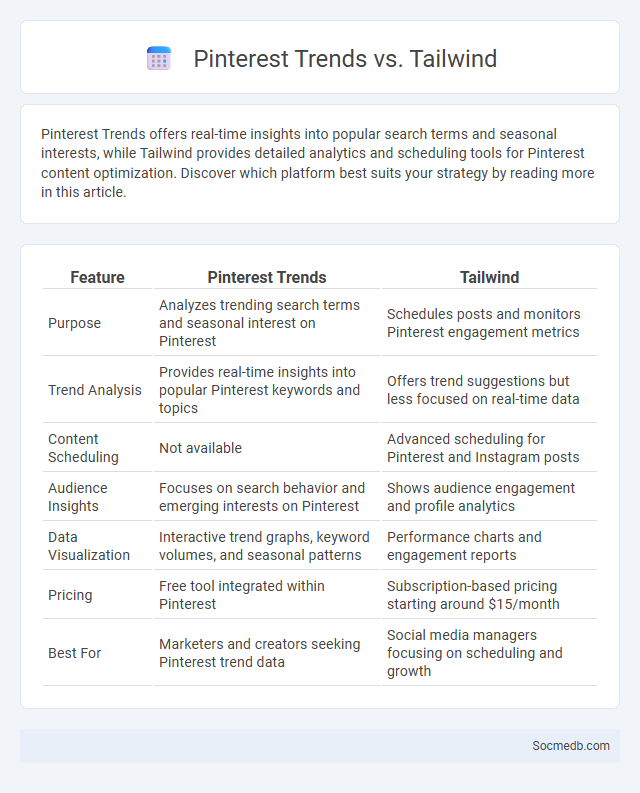
Photo illustration: Pinterest Trends vs Tailwind
Pinterest Trends offers real-time insights into popular search terms and seasonal interests, while Tailwind provides detailed analytics and scheduling tools for Pinterest content optimization. Discover which platform best suits your strategy by reading more in this article.
Table of Comparison
| Feature | Pinterest Trends | Tailwind |
|---|---|---|
| Purpose | Analyzes trending search terms and seasonal interest on Pinterest | Schedules posts and monitors Pinterest engagement metrics |
| Trend Analysis | Provides real-time insights into popular Pinterest keywords and topics | Offers trend suggestions but less focused on real-time data |
| Content Scheduling | Not available | Advanced scheduling for Pinterest and Instagram posts |
| Audience Insights | Focuses on search behavior and emerging interests on Pinterest | Shows audience engagement and profile analytics |
| Data Visualization | Interactive trend graphs, keyword volumes, and seasonal patterns | Performance charts and engagement reports |
| Pricing | Free tool integrated within Pinterest | Subscription-based pricing starting around $15/month |
| Best For | Marketers and creators seeking Pinterest trend data | Social media managers focusing on scheduling and growth |
Introduction to Visual Trend Platforms
Visual trend platforms analyze emerging patterns in design, fashion, and digital content by aggregating data from social media channels such as Instagram, Pinterest, and TikTok. These platforms utilize AI algorithms to identify and predict shifts in aesthetic preferences, providing brands and marketers with actionable insights. Leveraging visual trend platforms enhances content strategies, ensuring alignment with real-time consumer interests and cultural movements.
Overview of Pinterest Trends
Pinterest Trends reveal real-time insights into what topics, keywords, and images are gaining popularity on the platform, allowing marketers and creators to tailor content for maximum engagement. This tool highlights seasonal patterns, emerging pins, and audience interests, helping you capitalize on trending niches and improve your reach. Understanding Pinterest Trends enables strategic planning for campaigns based on user behavior and visual search data.
Key Features of Tailwind
Tailwind offers advanced scheduling tools that automate posts for Instagram, Pinterest, and Facebook, optimizing timing based on audience engagement patterns. Its visual content calendar simplifies campaign planning, while in-depth analytics track hashtag performance, follower growth, and post effectiveness. Tailwind also includes smart hashtag suggestions and drag-and-drop functionality to streamline the content creation process and boost social media reach.
Exploring Google Trends
Google Trends offers valuable insights into the popularity of social media topics by analyzing search volume data over time. Your ability to identify trending hashtags, keywords, and audience interests enhances content strategy and boosts engagement. Leveraging Google Trends empowers you to stay ahead of social media dynamics and tailor your campaigns effectively.
Data Sources and Analytics Comparison
Social media platforms generate vast amounts of data from user interactions, including likes, shares, comments, and clicks, which serve as primary data sources for analytics. Comparing analytics tools such as Facebook Insights, Twitter Analytics, and Google Analytics reveals varying capabilities in tracking audience demographics, engagement metrics, and conversion rates. Understanding these differences helps businesses select the most effective platform-specific analytics to optimize social media marketing strategies and improve ROI.
User Experience and Interface
User experience (UX) and user interface (UI) design in social media platforms prioritize intuitive navigation, responsiveness, and personalized content delivery to enhance engagement and satisfaction. Optimizing UI elements such as icons, buttons, and layout ensures accessibility across devices, reducing user friction and increasing session duration. Incorporating data-driven insights and A/B testing refines interaction flows and visual hierarchy, leading to improved retention and user loyalty.
Best Use Cases for Each Platform
Instagram excels for visually-driven brands seeking to engage audiences through high-quality images and Stories, boosting product discovery and brand awareness. LinkedIn is ideal for B2B companies aiming to network, share industry insights, and generate professional leads. Your choice depends on aligning each platform's unique strengths with your business goals to maximize social media ROI.
Pricing and Accessibility
Social media platforms offer diverse pricing models, ranging from free basic access to subscription-based premium features, enabling users to choose according to their needs and budget. Accessibility is enhanced through mobile apps, web interfaces, and support for multiple languages, ensuring inclusive user experiences globally. Strategic investments in scalable infrastructure help maintain reliable service availability for billions of users worldwide.
Strengths and Limitations
Social media offers powerful strengths such as instant global connectivity, real-time information sharing, and enhanced brand visibility, enabling you to reach diverse audiences effectively. However, limitations include the risk of misinformation, privacy concerns, algorithm-driven content bubbles, and potential negative impacts on mental health. Balancing these advantages and challenges is crucial for maximizing your social media strategy's success.
Choosing the Right Trend Tool for Your Strategy
Selecting the right trend tool is essential for optimizing your social media strategy and staying ahead in the digital landscape. Tools like Google Trends, BuzzSumo, and TrendSpottr analyze real-time data to identify emerging topics and audience interests. Using your chosen tool effectively allows you to tailor content that resonates with your target market, boosting engagement and reach.
 socmedb.com
socmedb.com